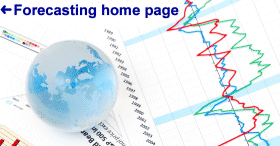Principles and risks
of forecasting (pdf)
Famous forecasting
quotes
How to move data around
Get to know your
data
Inflation adjustment (deflation)
Seasonal adjustment
Stationarity and differencing
The logarithm transformation
Get to know your data
Data sources and units: Before you even begin to analyze your data, you should ask:
- Where
did it come from? (How was it originally recorded? By whom? How
frequently? Under what conditions? How accurately and consistently?)
- Where
has it been? (What other systems has it passed through? How has it been
adjusted, aggregated, averaged, or otherwise massaged?)
- Is
it clean or dirty? (Are there data entry errors? Missing data? Misalignment
of time periods? Changes in reporting practices? Bizarre events?) And last
but not least...
- In
what units is it measured? (1's or trillions? Dollars or customers
or items sold? Price per item or price per kilo? Has it been seasonally
adjusted, and if so, how? Is it measured in monthly totals or an annual
rate? In nominal or constant (inflation-adjusted) units of currency? Does
it represent the current level of something, or does it represent
the absolute change from one period to another, or the percentage
change from one period to another? Are the units compatible
among variables?)
Later, when you write up the results
of your analysis, the variables in your data set should be clearly annotated to
indicate their sources, units of measurement, and any problems or peculiarities
you are aware of.
The bad news
here is that assembling, cleaning, adjusting, and documenting the units of the
data is often the most tedious step of forecasting, and failure to attend to
these mundane details may lead to egregious errors of modeling. Fortunes may be
lost and heads may roll. The good news is that you often learn a good deal in
the process, gaining insight into the nature and logical relationships of the
variables you wish to predict.
You may also
find that the most important management benefit of your forecasting project is
to identify ways in which your organization's data can be better collected,
better organized, better integrated, and better summarized for purposes of
decision-making.
Draw
the #!*$ picture: Before you crunch a single number,
you should graph your data to get a feel for its qualitative properties.
For example, suppose you are studying the history of economic growth in the
U.S. over the period from 1992 to the present. Here's a time series plot of one
very important measure, total retail sales:
Note that
data are in millions of dollars, not adjusted for inflation and not seasonally
adjusted ("NSA"). The chart and data were obtained from http://economagic.com/, a highly recommended
source for economic data.
What
qualitative features are evident on this graph? You might notice some of the
following:
- Overall
there is a very strong upward trend, which is due to a combination of
inflationary growth and real growth.
- A
huge drop occurred during the Great Recession.
- There
is a very pronounced seasonal pattern.
- The
amplitude of the seasonal variation has grown roughly in proportion to the
level of sales, which is to say, it seems consistent over time in
percentage rather than absolute terms. (This is a so-called "multiplicative"
seasonal pattern, which is typically seen in measures of economic
activity.)
A
forecasting model for this time series must accommodate all these qualitative
features, and ideally it should shed light on their underlying causes. To study
these features of the time series in more depth, and to help determine which
kind of forecasting model is most appropriate, we should next plot some transformations of the
original data.
Go on to next topic: Inflation
adjustment (deflation)

